Exploring an Integrated System for Urban Stormwater Management: A Systematic Literature Review of Solutions at Building and District Scales
Abstract
1. Introduction
2. Materials and Methods
2.1. Step 1
2.2. Step 2
- Domain 1: Heavy rain OR flood* OR intense rain OR heavy storm OR storm water OR stormwater OR flash flood* OR extreme rainfall OR pluvial flood* OR heavy rainfall.
- Domain 2: Mitigation effect OR mitigation OR rainwater management OR water management OR adaptation OR water retaining capacity OR response capacity OR water detention OR stormwater treatment OR flood risk management.
- Domain 3: Green roof* OR vegetated roof* OR vegetative roof* OR eco-roof* OR nature-based solution* OR NBS OR ecosystem-based solution* OR (blue and green infrastructure) OR BGI OR green infrastructure OR bioretention system*.
- Domain 4: (1) Building*; (2) district* OR neighborhood* OR neighborhood* OR community*; (3) urban OR city*.
- Building scale: 416 records were identified; 130 duplications were removed; 286 records were selected for the screening process; and 37 articles were considered eligible.
- District scale: 604 records were identified; 169 duplications were removed; 435 records were selected for the screening process; and 36 articles were considered eligible.
3. Results
3.1. Results of Step 1
3.2. Results of Step 2
3.2.1. Analysis of the Inner Relations of Four Domains
3.2.2. Analysis of the Investigated Research Focus
4. Discussion
5. Conclusions
Author Contributions
Funding
Institutional Review Board Statement
Informed Consent Statement
Data Availability Statement
Conflicts of Interest
References
- United Nations, Department of Economic and Social Affairs, Population Division. World Population Prospects 2019: Highlights; United Nations: New York, NY, USA, 2019; ISBN 978-92-1-148316-1. [Google Scholar]
- Clarke, B.; Otto, F.; Stuart-Smith, R.; Harrington, L. Extreme Weather Impacts of Climate Change: An Attribution Perspective. Environ. Res. Clim. 2022, 1, 012001. [Google Scholar] [CrossRef]
- Seneviratne, S.I.; Zhang, X.; Adnan, M.; Badi, W.; Dereczynski, C.; Di Luca, A.; Ghosh, S.; Iskandar, I.; Kossin, J.; Lewis, S.; et al. Weather and Climate Extreme Events in a Changing Climate. In Climate Change 2021: The Physical Science Basis. Contribution of Working Group I to the Sixth Assessment Report of the Intergovernmental Panel on Climate Change; Masson-Delmotte, V., Zhai, P., Pirani, A., Connors, S.L., Péan, C., Berger, S., Caud, N., Chen, Y., Goldfarb, L., Gomis, M.I., et al., Eds.; Cambridge University Press: Cambridge, UK; New York, NY, USA, 2021; pp. 1513–1766. [Google Scholar]
- Roxy, M.K.; Ghosh, S.; Pathak, A.; Athulya, R.; Mujumdar, M.; Murtugudde, R.; Terray, P.; Rajeevan, M. A Threefold Rise in Widespread Extreme Rain Events over Central India. Nat. Commun. 2017, 8, 708. [Google Scholar] [CrossRef] [PubMed]
- Myhre, G.; Alterskjær, K.; Stjern, C.W.; Hodnebrog, Ø.; Marelle, L.; Samset, B.H.; Sillmann, J.; Schaller, N.; Fischer, E.; Schulz, M.; et al. Frequency of Extreme Precipitation Increases Extensively with Event Rareness under Global Warming. Sci. Rep. 2019, 9, 16063. [Google Scholar] [CrossRef]
- Tabari, H. Climate Change Impact on Flood and Extreme Precipitation Increases with Water Availability. Sci. Rep. 2020, 10, 13768. [Google Scholar] [CrossRef]
- Bowman, D.M.J.S.; Williamson, G.J.; Abatzoglou, J.T.; Kolden, C.A.; Cochrane, M.A.; Smith, A.M.S. Human Exposure and Sensitivity to Globally Extreme Wildfire Events. Nat. Ecol. Evol. 2017, 1, 0058. [Google Scholar] [CrossRef] [PubMed]
- Krikken, F.; Lehner, F.; Haustein, K.; Drobyshev, I.; Van Oldenborgh, G.J. Attribution of the Role of Climate Change in the Forest Fires in Sweden 2018. Nat. Hazards Earth Syst. Sci. Atmos. 2019, 21, 2169–2179. [Google Scholar] [CrossRef]
- Van Oldenborgh, G.J.; Krikken, F.; Lewis, S.; Leach, N.J.; Lehner, F.; Saunders, K.R.; Van Weele, M.; Haustein, K.; Li, S.; Wallom, D.; et al. Attribution of the Australian Bushfire Risk to Anthropogenic Climate Change. Nat. Hazards Earth Syst. Sci. Atmos. 2020, 21, 941–960. [Google Scholar] [CrossRef]
- Griego, A.L.; Flores, A.B.; Collins, T.W.; Grineski, S.E. Social Vulnerability, Disaster Assistance, and Recovery: A Population-Based Study of Hurricane Harvey in Greater Houston, Texas. Int. J. Disaster Risk Reduct. 2020, 51, 101766. [Google Scholar] [CrossRef]
- Caretta, M.A.; Mukherji, A.; Arfanuzzaman, M.; Betts, R.A.; Gelfan, A.; Hirabayashi, Y.; Lissner, T.K.; Lopez Gunn, E.; Liu, J.; Morgan, R.; et al. Water. In Climate Change 2022: Impacts, Adaptation and Vulnerability. Contribution of Working Group II to the Sixth Assessment Report of the Intergovernmental Panel on Climate Change; Pörtner, H.-O., Roberts, D.C., Tignor, M.M.B., Poloczanska, E.S., Mintenbeck, K., Alegría, A., Craig, M., Langsdorf, S., Löschke, S., Möller, V., et al., Eds.; Cambridge University Press: Cambridge, UK, 2022. [Google Scholar]
- Mekonnen, M.M.; Hoekstra, A.Y. Four Billion People Facing Severe Water Scarcity. Sci. Adv. 2016, 2, e1500323. [Google Scholar] [CrossRef]
- Coban, H.H. Simulation of a Pumped Stormwater System and Evaluation of the Solar Potential for Pumping. J. Smart Sci. Technol. 2023, 3, 1–13. [Google Scholar] [CrossRef]
- Klein, R.J.; Midglev, G.F.; Preston, B.L.; Alam, M.; Berkhout, F.G.; Dow, K.; Shaw, M.R. AR5 Climate Change 2014: Impacts, Adaptation, and Vulnerability; IPCC: Stockholm, Sweden, 2014. [Google Scholar]
- Liu, L.; Fryd, O.; Zhang, S. Blue-Green Infrastructure for Sustainable Urban Stormwater Management—Lessons from Six Municipality-Led Pilot Projects in Beijing and Copenhagen. Water 2019, 11, 2024. [Google Scholar] [CrossRef]
- Mentens, J.; Raes, D.; Hermy, M. Green Roofs as a Tool for Solving the Rainwater Runoff Problem in the Urbanized 21st Century? Landsc. Urban Plan. 2006, 77, 217–226. [Google Scholar] [CrossRef]
- Prudencio, L.; Null, S.E. Stormwater Management and Ecosystem Services: A Review. Environ. Res. Lett. 2018, 13, 033002. [Google Scholar] [CrossRef]
- Liu, L.; Jensen, M.B. Green Infrastructure for Sustainable Urban Water Management: Practices of Five Forerunner Cities. Cities 2018, 74, 126–133. [Google Scholar] [CrossRef]
- Fletcher, T.D.; Shuster, W.; Hunt, W.F.; Ashley, R.; Butler, D.; Arthur, S.; Trowsdale, S.; Barraud, S.; Semadeni-Davies, A.; Bertrand-Krajewski, J.-L.; et al. SUDS, LID, BMPs, WSUD and More—The Evolution and Application of Terminology Surrounding Urban Drainage. Urban Water J. 2015, 12, 525–542. [Google Scholar] [CrossRef]
- Jia, H.; Wang, Z.; Zhen, X.; Clar, M.; Yu, S.L. China’s Sponge City Construction: A Discussion on Technical Approaches. Front. Environ. Sci. Eng. 2017, 11, 18. [Google Scholar] [CrossRef]
- European Commission. Directorate General for Research and Innovation. Towards an EU Research and Innovation Policy Agenda for Nature-Based Solutions & Re-Naturing Cities: Final Report of the Horizon 2020 Expert Group on ‘Nature Based Solutions and Re Naturing Cities’: (Full Version); Publications Office of the European Union: Luxembourg, 2015. [Google Scholar]
- Calheiros, C.S.C.; Stefanakis, A.I. Green Roofs Towards Circular and Resilient Cities. Circ. Econ. Sustain. 2021, 1, 395–411. [Google Scholar] [CrossRef] [PubMed]
- Shafique, M.; Kim, R.; Kyung-Ho, K. Green Roof for Stormwater Management in a Highly Urbanized Area: The Case of Seoul, Korea. Sustainability 2018, 10, 584. [Google Scholar] [CrossRef]
- Lundholm, J.T.; Williams, N.S.G. Effects of Vegetation on Green Roof Ecosystem Services. In Green Roof Ecosystems; Ecological Studies; Sutton, R.K., Ed.; Springer International Publishing: Cham, Switzerland, 2015; Volume 223, pp. 211–232. ISBN 978-3-319-14982-0. [Google Scholar]
- Morales-Torres, A.; Escuder-Bueno, I.; Andrés-Doménech, I.; Perales-Momparler, S. Decision Support Tool for Energy-Efficient, Sustainable and Integrated Urban Stormwater Management. Environ. Model. Softw. 2016, 84, 518–528. [Google Scholar] [CrossRef]
- Mayrand, F.; Clergeau, P. Green Roofs and Green Walls for Biodiversity Conservation: A Contribution to Urban Connectivity? Sustainability 2018, 10, 985. [Google Scholar] [CrossRef]
- Castleton, H.F.; Stovin, V.; Beck, S.B.M.; Davison, J.B. Green Roofs; Building Energy Savings and the Potential for Retrofit. Energy Build. 2010, 42, 1582–1591. [Google Scholar] [CrossRef]
- Luo, H.; Wang, N.; Chen, J.; Ye, X.; Sun, Y.-F. Study on the Thermal Effects and Air Quality Improvement of Green Roof. Sustainability 2015, 7, 2804–2817. [Google Scholar] [CrossRef]
- Shafique, M.; Xue, X.; Luo, X. An Overview of Carbon Sequestration of Green Roofs in Urban Areas. Urban For. Urban Green. 2020, 47, 126515. [Google Scholar] [CrossRef]
- Stovin, V.; Vesuviano, G.; Kasmin, H. The Hydrological Performance of a Green Roof Test Bed under UK Climatic Conditions. J. Hydrol. 2012, 414–415, 148–161. [Google Scholar] [CrossRef]
- Oral, H.V.; Carvalho, P.; Gajewska, M.; Ursino, N.; Masi, F.; Hullebusch, E.D.V.; Kazak, J.K.; Exposito, A.; Cipolletta, G.; Andersen, T.R.; et al. A Review of Nature-Based Solutions for Urban Water Management in European Circular Cities: A Critical Assessment Based on Case Studies and Literature. Blue-Green Syst. 2020, 2, 112–136. [Google Scholar] [CrossRef]
- Huang, Y.; Tian, Z.; Ke, Q.; Liu, J.; Irannezhad, M.; Fan, D.; Hou, M.; Sun, L. Nature-based Solutions for Urban Pluvial Flood Risk Management. WIREs Water 2020, 7, e1421. [Google Scholar] [CrossRef]
- Malaviya, P.; Sharma, R.; Sharma, P.K. Rain Gardens as Stormwater Management Tool. In Sustainable Green Technologies for Environmental Management; Shah, S., Venkatramanan, V., Prasad, R., Eds.; Springer: Singapore, 2019; pp. 141–166. ISBN 9789811327711. [Google Scholar]
- Dechesne, M.; Barraud, S.; Bardin, J.-P. Experimental Assessment of Stormwater Infiltration Basin Evolution. J. Environ. Eng. 2005, 131, 1090–1098. [Google Scholar] [CrossRef]
- Birch, G.F.; Fazeli, M.S.; Matthai, C. Efficiency of an infiltration basin in removing contaminants from urban stormwater. Environ. Monit. Assess. 2005, 101, 23–38. [Google Scholar] [CrossRef]
- Alves, A.; Sanchez, A.; Vojinovic, Z.; Seyoum, S.; Babel, M.; Brdjanovic, D. Evolutionary and Holistic Assessment of Green-Grey Infrastructure for CSO Reduction. Water 2016, 8, 402. [Google Scholar] [CrossRef]
- Alves, A.; Vojinovic, Z.; Kapelan, Z.; Sanchez, A.; Gersonius, B. Exploring Trade-Offs among the Multiple Benefits of Green-Blue-Grey Infrastructure for Urban Flood Mitigation. Sci. Total Environ. 2020, 703, 134980. [Google Scholar] [CrossRef]
- Vojinovic, Z.; Keerakamolchai, W.; Weesakul, S.; Pudar, R.; Medina, N.; Alves, A. Combining Ecosystem Services with Cost-Benefit Analysis for Selection of Green and Grey Infrastructure for Flood Protection in a Cultural Setting. Environments 2016, 4, 3. [Google Scholar] [CrossRef]
- Onuma, A.; Tsuge, T. Comparing Green Infrastructure as Ecosystem-Based Disaster Risk Reduction with Gray Infrastructure in Terms of Costs and Benefits under Uncertainty: A Theoretical Approach. Int. J. Disaster Risk Reduct. 2018, 32, 22–28. [Google Scholar] [CrossRef]
- Webber, J.L.; Fu, G.; Butler, D. Rapid Surface Water Intervention Performance Comparison for Urban Planning. Water Sci. Technol. 2018, 77, 2084–2092. [Google Scholar] [CrossRef]
- Prisma. Available online: http://prisma-statement.org/PRISMAStatement/FlowDiagram (accessed on 9 May 2023).
- Zhang, D.; Gersberg, R.M.; Ng, W.J.; Tan, S.K. Conventional and Decentralized Urban Stormwater Management: A Comparison through Case Studies of Singapore and Berlin, Germany. Urban Water J. 2017, 14, 113–124. [Google Scholar] [CrossRef]
- Fitzgerald, J.; Laufer, J. Governing Green Stormwater Infrastructure: The Philadelphia Experience. Local Environ. 2017, 22, 256–268. [Google Scholar] [CrossRef]
- Tredway, J.C.; Havlick, D.G. Assessing the Potential of Low-Impact Development Techniques on Runoff and Streamflow in the Templeton Gap Watershed, Colorado. Prof. Geogr. 2017, 69, 372–382. [Google Scholar] [CrossRef]
- Finewood, M.H.; Matsler, A.M.; Zivkovich, J. Green Infrastructure and the Hidden Politics of Urban Stormwater Governance in a Postindustrial City. Ann. Am. Assoc. Geogr. 2019, 109, 909–925. [Google Scholar] [CrossRef]
- Steis Thorsby, J.; Miller, C.J.; Treemore-Spears, L. The Role of Green Stormwater Infrastructure in Flood Mitigation (Detroit, MI USA)—Case Study. Urban Water J. 2020, 17, 838–846. [Google Scholar] [CrossRef]
- Sheikh, V.; Izanloo, R. Assessment of Low Impact Development Stormwater Management Alternatives in the City of Bojnord, Iran. Urban Water J. 2021, 18, 449–464. [Google Scholar] [CrossRef]
- Walker, R.H. Engineering Gentrification: Urban Redevelopment, Sustainability Policy, and Green Stormwater Infrastructure in Minneapolis. J. Environ. Policy Plan. 2021, 23, 646–664. [Google Scholar] [CrossRef]
- Simmons, M.T.; Gardiner, B.; Windhager, S.; Tinsley, J. Green Roofs Are Not Created Equal: The Hydrologic and Thermal Performance of Six Different Extensive Green Roofs and Reflective and Non-Reflective Roofs in a Sub-Tropical Climate. Urban Ecosyst. 2008, 11, 339–348. [Google Scholar] [CrossRef]
- Wang, X.; Tian, Y.; Zhao, X.; Peng, C. Hydrological Performance of Dual-Substrate-Layer Green Roofs Using Porous Inert Substrates with High Sorption Capacities. Water Sci. Technol. 2017, 75, 2829–2840. [Google Scholar] [CrossRef]
- Akther, M.; He, J.; Chu, A.; Huang, J.; Van Duin, B. A Review of Green Roof Applications for Managing Urban Stormwater in Different Climatic Zones. Sustainability 2018, 10, 2864. [Google Scholar] [CrossRef]
- Schultz, I.; Sailor, D.J.; Starry, O. Effects of Substrate Depth and Precipitation Characteristics on Stormwater Retention by Two Green Roofs in Portland OR. J. Hydrol. Reg. Stud. 2018, 18, 110–118. [Google Scholar] [CrossRef]
- Singh, S.G. A Systematic Approach for Effective Storm Water Management at Building Level during Extreme Rainfall Events—A Case Study. Urban Water J. 2022, 1–11. [Google Scholar] [CrossRef]
- Sadeghi, K.M.; Kharaghani, S.; Tam, W.; Gaerlan, N.; Loáiciga, H. Green Stormwater Infrastructure (GSI) for Stormwater Management in the City of Los Angeles: Avalon Green Alleys Network. Environ. Process. 2019, 6, 265–281. [Google Scholar] [CrossRef]
- Todorov, D.; Driscoll, C.T.; Todorova, S. Long-term and Seasonal Hydrologic Performance of an Extensive Green Roof. Hydrol. Process. 2018, 32, 2471–2482. [Google Scholar] [CrossRef]
- Kok, K.H.; Mohd Sidek, L.; Chow, M.F.; Zainal Abidin, M.R.; Basri, H.; Hayder, G. Evaluation of Green Roof Performances for Urban Stormwater Quantity and Quality Controls. Int. J. River Basin Manag. 2016, 14, 1–7. [Google Scholar] [CrossRef]
- Charlesworth, S.M.; Perales-Momparler, S.; Lashford, C.; Warwick, F. The Sustainable Management of Surface Water at the Building Scale: Preliminary Results of Case Studies in the UK and Spain. J. Water Supply Res. Technol. Aqua 2013, 62, 534–544. [Google Scholar] [CrossRef]
- Versini, P.-A.; Stanic, F.; Gires, A.; Schertzer, D.; Tchiguirinskaia, I. Measurements of the Water Balance Components of a Large Green Roof in the Greater Paris Area. Earth Syst. Sci. Data 2020, 12, 1025–1035. [Google Scholar] [CrossRef]
- Andrés-Doménech, I.; Perales-Momparler, S.; Morales-Torres, A.; Escuder-Bueno, I. Hydrological Performance of Green Roofs at Building and City Scales under Mediterranean Conditions. Sustainability 2018, 10, 3105. [Google Scholar] [CrossRef]
- Boguniewicz-Zabłocka, J.; Capodaglio, A.G. Analysis of Alternatives for Sustainable Stormwater Management in Small Developments of Polish Urban Catchments. Sustainability 2020, 12, 10189. [Google Scholar] [CrossRef]
- Taura, F.; Ohme, M.; Shimatani, Y. Collaborative Development of Green Infrastructure: Urban Flood Control Measures on Small-Scale Private Lands. JDR 2021, 16, 457–468. [Google Scholar] [CrossRef]
- Speak, A.F.; Rothwell, J.J.; Lindley, S.J.; Smith, C.L. Rainwater Runoff Retention on an Aged Intensive Green Roof. Sci. Total Environ. 2013, 461–462, 28–38. [Google Scholar] [CrossRef] [PubMed]
- Tan, K.M.; Seow, W.K.; Wang, C.L.; Kew, H.J.; Parasuraman, S.B. Evaluation of Performance of Active, Beautiful and Clean (ABC) on Stormwater Runoff Management Using MIKE URBAN: A Case Study in a Residential Estate in Singapore. Urban Water J. 2019, 16, 156–162. [Google Scholar] [CrossRef]
- Biswal, B.K.; Bolan, N.; Zhu, Y.-G.; Balasubramanian, R. Nature-Based Systems (NbS) for Mitigation of Stormwater and Air Pollution in Urban Areas: A Review. Resour. Conserv. Recycl. 2022, 186, 106578. [Google Scholar] [CrossRef]
- Yang, B.; Li, S.; Wall, H.A.; Blackmore, P.; Wang, Z. Green Infrastructure Design for Improving Stormwater Quality: Daybreak Community in the United States West. Landsc. Archit. Front. 2015, 3, 12–21. [Google Scholar]
- Fleck, R.; Westerhausen, M.T.; Killingsworth, N.; Ball, J.; Torpy, F.R.; Irga, P.J. The Hydrological Performance of a Green Roof in Sydney, Australia: A Tale of Two Towers. Build. Environ. 2022, 221, 109274. [Google Scholar] [CrossRef]
- Todorov, D.; Driscoll, C.T.; Todorova, S.; Montesdeoca, M. Water Quality Function of an Extensive Vegetated Roof. Sci. Total Environ. 2018, 625, 928–939. [Google Scholar] [CrossRef]
- Rosenberger, L.; Leandro, J.; Pauleit, S.; Erlwein, S. Sustainable Stormwater Management under the Impact of Climate Change and Urban Densification. J. Hydrol. 2021, 596, 126137. [Google Scholar] [CrossRef]
- Liu, C.; Li, Y. Measuring Eco-Roof Mitigation on Flash Floods via GIS Simulation. BEPAM 2016, 6, 415–427. [Google Scholar] [CrossRef]
- Fu, X.; Wang, D.; Luan, Q.; Liu, J.; Wang, Z.; Tian, J. Community Scale Assessment of the Effectiveness of Designed Discharge Routes from Building Roofs for Stormwater Reduction. Remote Sens. 2022, 14, 2970. [Google Scholar] [CrossRef]
- Zhang, Y.; Zhao, W.; Chen, X.; Jun, C.; Hao, J.; Tang, X.; Zhai, J. Assessment on the Effectiveness of Urban Stormwater Management. Water 2020, 13, 4. [Google Scholar] [CrossRef]
- Li, Y.; Huang, J.J.; Hu, M.; Yang, H.; Tanaka, K. Design of Low Impact Development in the Urban Context Considering Hydrological Performance and Life-cycle Cost. J. Flood Risk Manag. 2020, 13, e12625. [Google Scholar] [CrossRef]
- Lee, E.S.; Lee, D.K.; Kim, S.H.; Lee, K.C. Design Strategies to Reduce Surface Water Flooding in a Historical District: Design Strategies to Reduce Surface Water Flooding. J. Flood Risk Manag. 2018, 11, S838–S854. [Google Scholar] [CrossRef]
- Zhang, X.; Guo, X.; Hu, M. Hydrological Effect of Typical Low Impact Development Approaches in a Residential District. Nat. Hazards 2016, 80, 389–400. [Google Scholar] [CrossRef]
- Liu, W.; Chen, W.; Peng, C. Influences of Setting Sizes and Combination of Green Infrastructures on Community’s Stormwater Runoff Reduction. Ecol. Model. 2015, 318, 236–244. [Google Scholar] [CrossRef]
- Liu, W.; Chen, W.; Peng, C. Assessing the Effectiveness of Green Infrastructures on Urban Flooding Reduction: A Community Scale Study. Ecol. Model. 2014, 291, 6–14. [Google Scholar] [CrossRef]
- Zhang, Y.; Xu, H.; Liu, H.; Zhou, B. The Application of Low Impact Development Facility Chain on Storm Rainfall Control: A Case Study in Shenzhen, China. Water 2021, 13, 3375. [Google Scholar] [CrossRef]
- Liu, R.; Stanford, R.L.; Deng, Y.; Liu, D.; Liu, Y.; Yu, S.L. The Influence of Extensive Green Roofs on Rainwater Runoff Quality: A Field-Scale Study in Southwest China. Environ. Sci. Pollut. Res. 2020, 27, 12932–12941. [Google Scholar] [CrossRef]
- Barbaro, G.; Miguez, M.; De Sousa, M.; Ribeiro Da Cruz Franco, A.; De Magalhães, P.; Foti, G.; Valadão, M.; Occhiuto, I. Innovations in Best Practices: Approaches to Managing Urban Areas and Reducing Flood Risk in Reggio Calabria (Italy). Sustainability 2021, 13, 3463. [Google Scholar] [CrossRef]
- Cristiano, E.; Annis, A.; Apollonio, C.; Pumo, D.; Urru, S.; Viola, F.; Deidda, R.; Pelorosso, R.; Petroselli, A.; Tauro, F.; et al. Multilayer Blue-Green Roofs as Nature-Based Solutions for Water and Thermal Insulation Management. Hydrol. Res. 2022, 53, 1129–1149. [Google Scholar] [CrossRef]
- Giacomello, E.; Gaspari, J. Hydrologic Performance of an Extensive Green Roof under Intense Rain Events: Results from a Rain-Chamber Simulation. Sustainability 2021, 13, 3078. [Google Scholar] [CrossRef]
- Pirouz, B.; Palermo, S.A.; Turco, M. Improving the Efficiency of Green Roofs Using Atmospheric Water Harvesting Systems (An Innovative Design). Water 2021, 13, 546. [Google Scholar] [CrossRef]
- Bortolini, L.; Bettella, F.; Zanin, G. Hydrological Behaviour of Extensive Green Roofs with Native Plants in the Humid Subtropical Climate Context. Water 2020, 13, 44. [Google Scholar] [CrossRef]
- Castro, A.S.; Goldenfum, J.A.; Da Silveira, A.L.; DallAgnol, A.L.B.; Loebens, L.; Demarco, C.F.; Leandro, D.; Nadaleti, W.C.; Quadro, M.S. The Analysis of Green Roof’s Runoff Volumes and Its Water Quality in an Experimental Study in Porto Alegre, Southern Brazil. Environ. Sci. Pollut. Res. 2020, 27, 9520–9534. [Google Scholar] [CrossRef] [PubMed]
- Longobardi, A.; D’Ambrosio, R.; Mobilia, M. Predicting Stormwater Retention Capacity of Green Roofs: An Experimental Study of the Roles of Climate, Substrate Soil Moisture, and Drainage Layer Properties. Sustainability 2019, 11, 6956. [Google Scholar] [CrossRef]
- Piro, P.; Carbone, M.; De Simone, M.; Maiolo, M.; Bevilacqua, P.; Arcuri, N. Energy and Hydraulic Performance of a Vegetated Roof in Sub-Mediterranean Climate. Sustainability 2018, 10, 3473. [Google Scholar] [CrossRef]
- Bortolini, L.; Zanin, G. Hydrological Behaviour of Rain Gardens and Plant Suitability: A Study in the Veneto Plain (North-Eastern Italy) Conditions. Urban For. Urban Green. 2018, 34, 121–133. [Google Scholar] [CrossRef]
- Yilmaz, D.; Sabre, M.; Lassabatère, L.; Dal, M.; Rodriguez, F. Storm Water Retention and Actual Evapotranspiration Performances of Experimental Green Roofs in French Oceanic Climate. Eur. J. Environ. Civ. Eng. 2016, 20, 344–362. [Google Scholar] [CrossRef]
- Lee, J.Y.; Lee, M.J.; Han, M. A Pilot Study to Evaluate Runoff Quantity from Green Roofs. J. Environ. Manag. 2015, 152, 171–176. [Google Scholar] [CrossRef]
- Wong, G.K.L.; Jim, C.Y. Quantitative Hydrologic Performance of Extensive Green Roof under Humid-Tropical Rainfall Regime. Ecol. Eng. 2014, 70, 366–378. [Google Scholar] [CrossRef]
- Lee, J.Y.; Moon, H.J.; Kim, T.I.; Kim, H.W.; Han, M.Y. Quantitative Analysis on the Urban Flood Mitigation Effect by the Extensive Green Roof System. Environ. Pollut. 2013, 181, 257–261. [Google Scholar] [CrossRef] [PubMed]
- Morgan, S.; Celik, S.; Retzlaff, W. Green Roof Storm-Water Runoff Quantity and Quality. J. Environ. Eng. 2013, 139, 471–478. [Google Scholar] [CrossRef]
- Bonoli, A.; Conte, A.; Maglionico, M.; Stojkov, I. Green roofs for sustainable water management in urban areas extended abstract. Environ. Eng. Manag. J. 2013, 12, 153–156. [Google Scholar]
- Castiglia Feitosa, R.; Wilkinson, S. Modelling Green Roof Stormwater Response for Different Soil Depths. Landsc. Urban Plan. 2016, 153, 170–179. [Google Scholar] [CrossRef]
- Silva, M.D.; Najjar, K.M.; Hammad, W.A.A.; Haddad, A.; Vazquez, E. Assessing the Retention Capacity of an Experimental Green Roof Prototype. Water 2019, 12, 90. [Google Scholar] [CrossRef]
- Burszta-Adamiak, E. Analysis of Stormwater Retention on Green Roofs/Badania Retencji Wód Opadowych Na Dachach Zielonych. Arch. Environ. Prot. 2012, 38, 3–13. [Google Scholar] [CrossRef]
- Sucheran, R.; Sucheran, A. Assessing the performance of green roofs for stormwater runoff mitigation in the south african urban environment. J. Urban Environ. Eng. 2021, 15, 159–172. [Google Scholar] [CrossRef]
- Zhang, Z.; Szota, C.; Fletcher, T.D.; Williams, N.S.G.; Werdin, J.; Farrell, C. Influence of Plant Composition and Water Use Strategies on Green Roof Stormwater Retention. Sci. Total Environ. 2018, 625, 775–781. [Google Scholar] [CrossRef]
- Cipolla, S.S.; Maglionico, M.; Stojkov, I. A Long-Term Hydrological Modelling of an Extensive Green Roof by Means of SWMM. Ecol. Eng. 2016, 95, 876–887. [Google Scholar] [CrossRef]
- Xie, H.; Liu, J.; Randall, M. Impact of Structural Factors on Green Roof Runoff—A Field Investigation and Statistical Analysis. J. Hydrol. 2022, 613, 128345. [Google Scholar] [CrossRef]
- Ershad Sarabi, S.; Han, Q.; Romme, L.A.G.; de Vries, B. Wendling Key Enablers of and Barriers to the Uptake and Implementation of Nature-Based Solutions in Urban Settings: A Review. Resources 2019, 8, 121. [Google Scholar] [CrossRef]



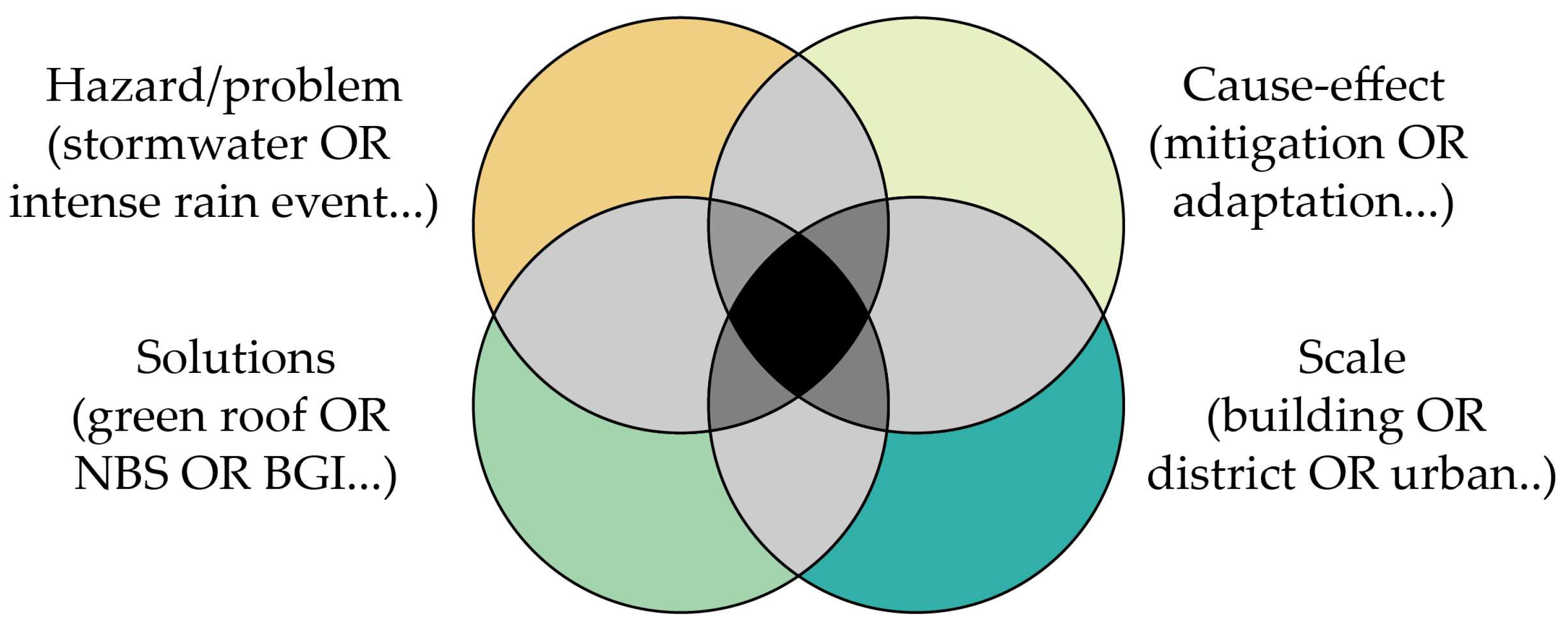
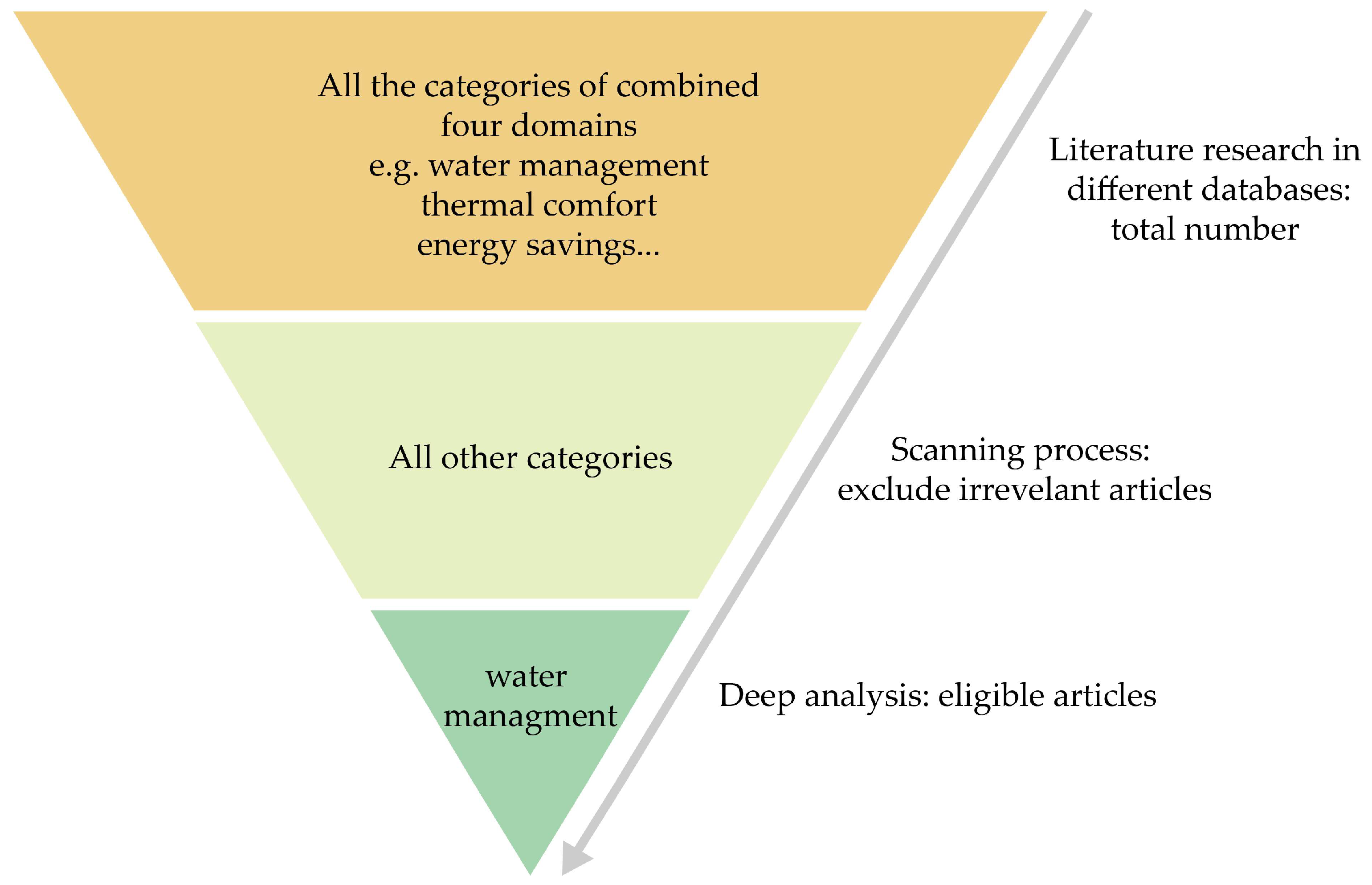
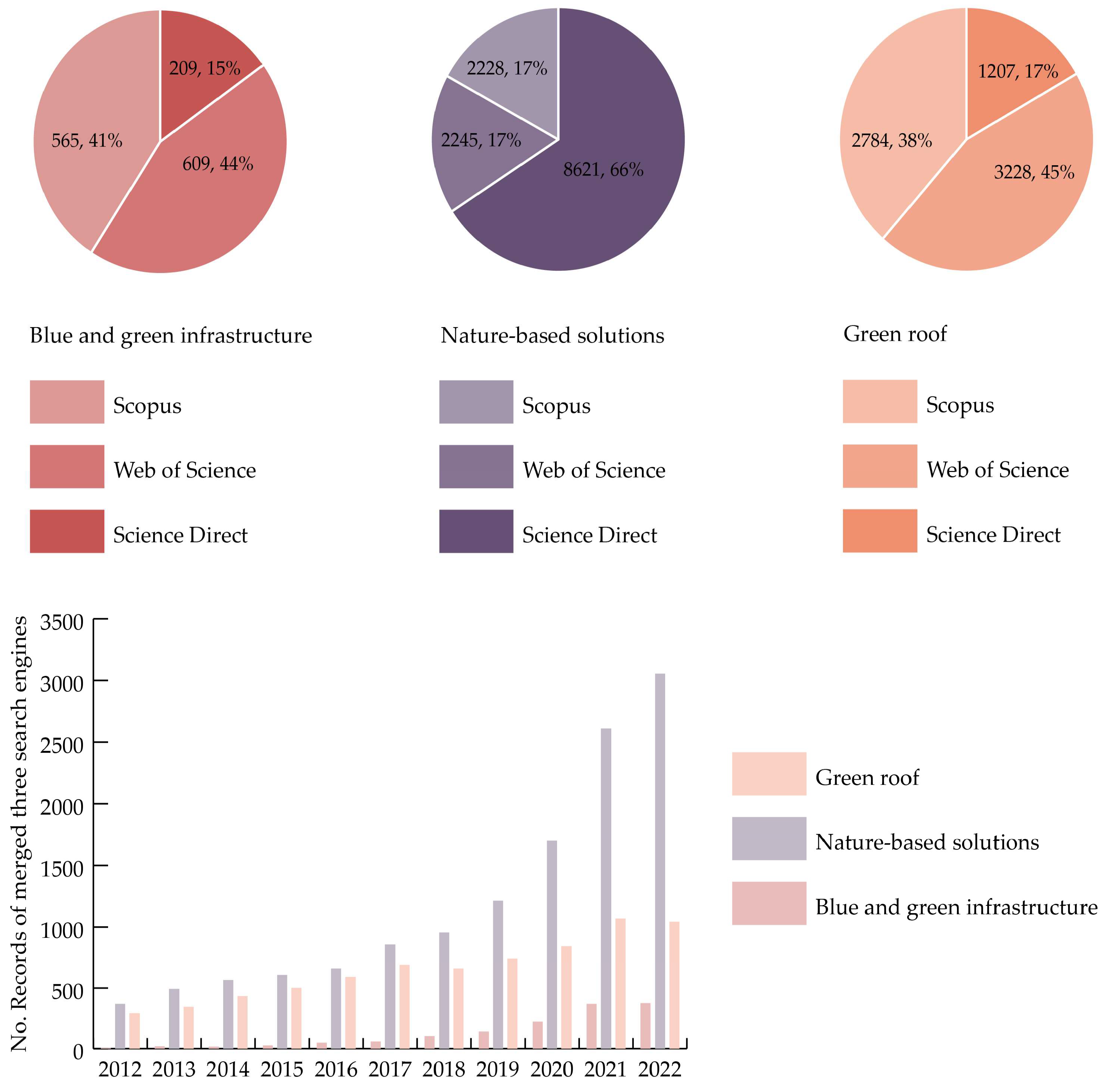
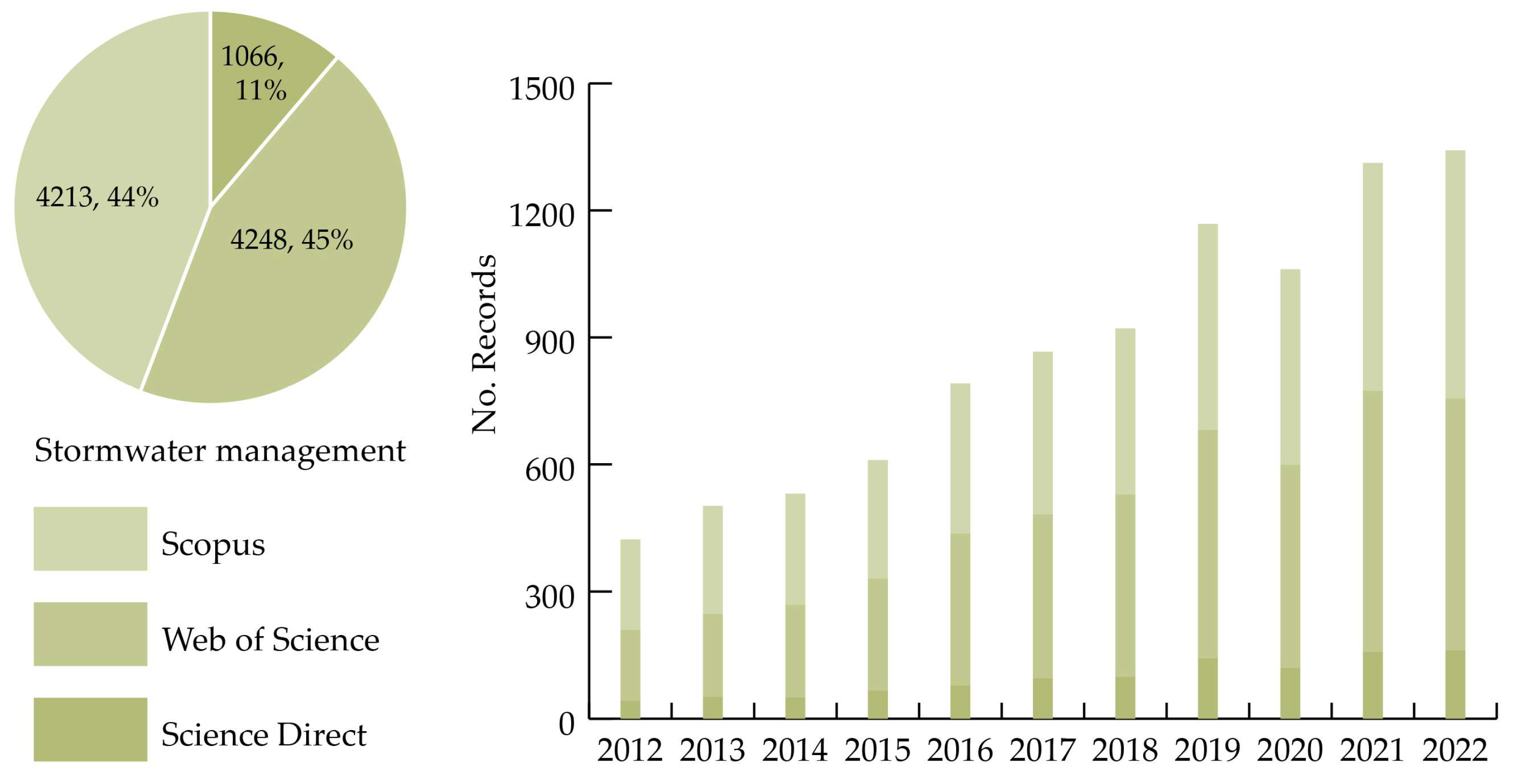
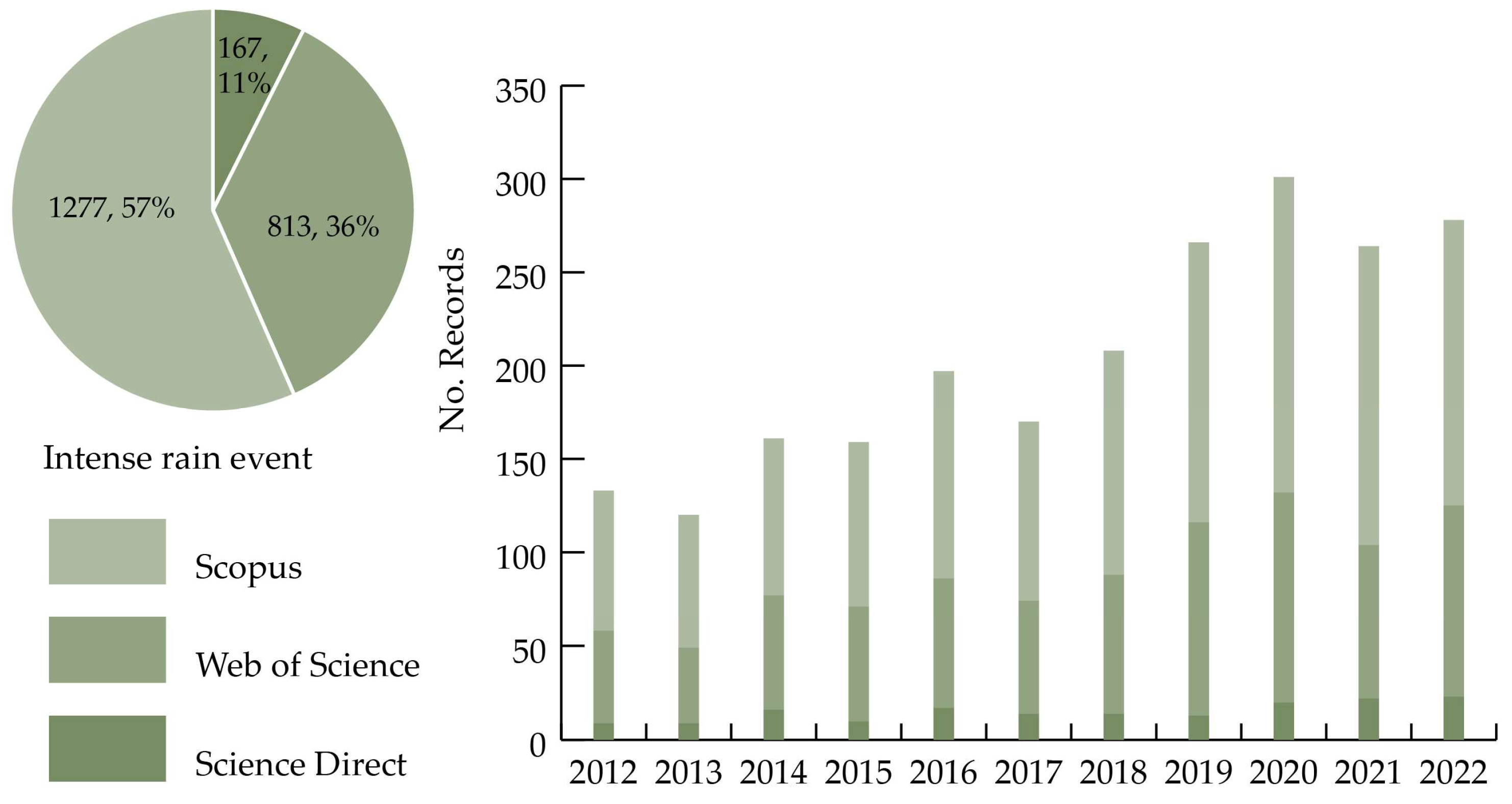
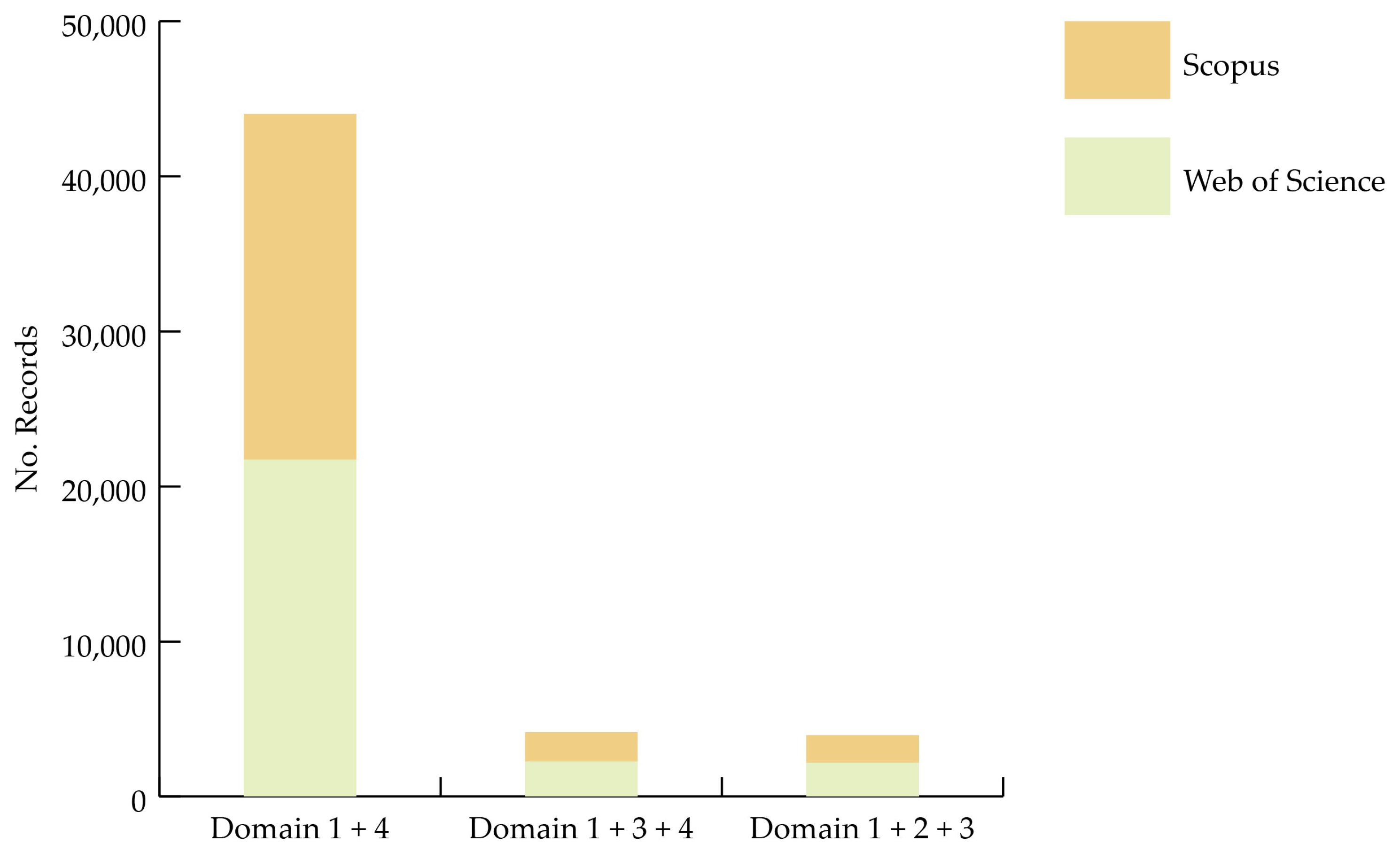
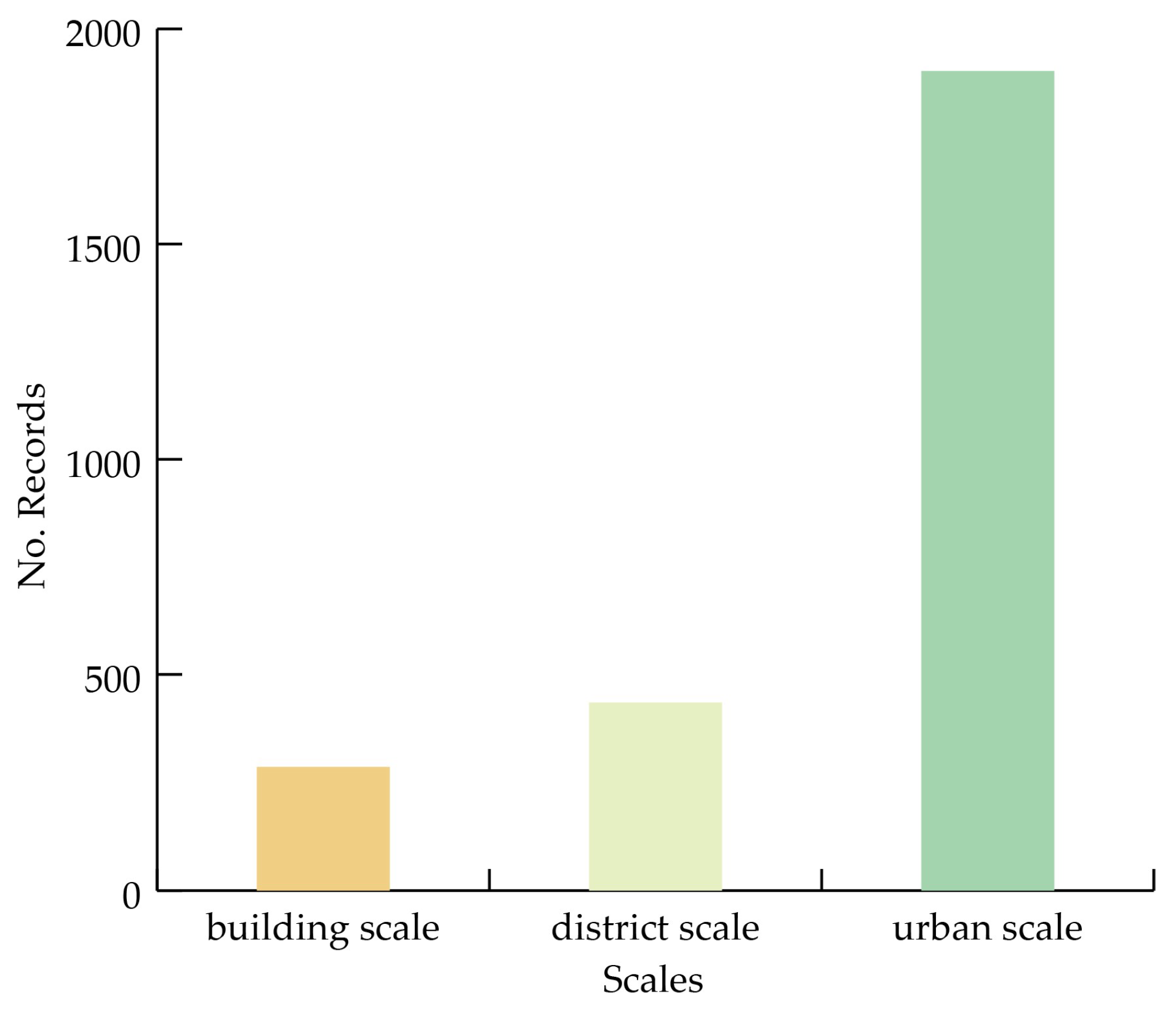

| Database | Categories |
|---|---|
| Web of Science | Environmental Sciences |
| Environmental Studies | |
| Green Sustainable Science Technology | |
| Water Resources | |
| Engineering Civil | |
| Engineering Environmental | |
| Ecology | |
| Geosciences Multidisciplinary | |
| Construction Building Technology | |
| Regional Urban Planning | |
| Urban Studies | |
| Architecture | |
| Scopus | Environmental Science |
| Engineering |
| S. No | Cluster | Reference | No. of Records |
|---|---|---|---|
| 1 | Runoff reduction | [23,53,54,55,56,57,58,59,60,61,62,63] | 12 |
| 2 | Runoff water quality | [64,65,66,67] | 4 |
| 3 | Field test | [46,68,69,70,71,72,73,74,75,76,77,78,79] | 13 |
| 4 | Experimental research | [80,81,82,83,84,85,86,87,88,89,90,91,92,93,94,95,96,97,98,99,100] | 21 |
| Total number of records | —— | 50 |
| Scale | Level | Actions | Reference |
|---|---|---|---|
| Building scale: Building or plot | Roof level | Green roof | [23,55,56,57,58,59,62] |
| Ground level | Infiltration basin | [53] | |
| Retention basin and rain garden | [60] | ||
| Crushed stones, rain garden, infiltration pipes, etc. | [61] | ||
| District scale: District or neighborhood or neighborhood or community | Ground level | Permeable pavers, infiltration trench and rain gardens | [54] |
| Rain gardens, bioretention lawns | [63] |
Disclaimer/Publisher’s Note: The statements, opinions and data contained in all publications are solely those of the individual author(s) and contributor(s) and not of MDPI and/or the editor(s). MDPI and/or the editor(s) disclaim responsibility for any injury to people or property resulting from any ideas, methods, instructions or products referred to in the content. |
© 2023 by the authors. Licensee MDPI, Basel, Switzerland. This article is an open access article distributed under the terms and conditions of the Creative Commons Attribution (CC BY) license (https://creativecommons.org/licenses/by/4.0/).
Share and Cite
Chen, Y.; Gaspari, J. Exploring an Integrated System for Urban Stormwater Management: A Systematic Literature Review of Solutions at Building and District Scales. Sustainability 2023, 15, 9984. https://doi.org/10.3390/su15139984
Chen Y, Gaspari J. Exploring an Integrated System for Urban Stormwater Management: A Systematic Literature Review of Solutions at Building and District Scales. Sustainability. 2023; 15(13):9984. https://doi.org/10.3390/su15139984
Chicago/Turabian StyleChen, Yu, and Jacopo Gaspari. 2023. "Exploring an Integrated System for Urban Stormwater Management: A Systematic Literature Review of Solutions at Building and District Scales" Sustainability 15, no. 13: 9984. https://doi.org/10.3390/su15139984
APA StyleChen, Y., & Gaspari, J. (2023). Exploring an Integrated System for Urban Stormwater Management: A Systematic Literature Review of Solutions at Building and District Scales. Sustainability, 15(13), 9984. https://doi.org/10.3390/su15139984








